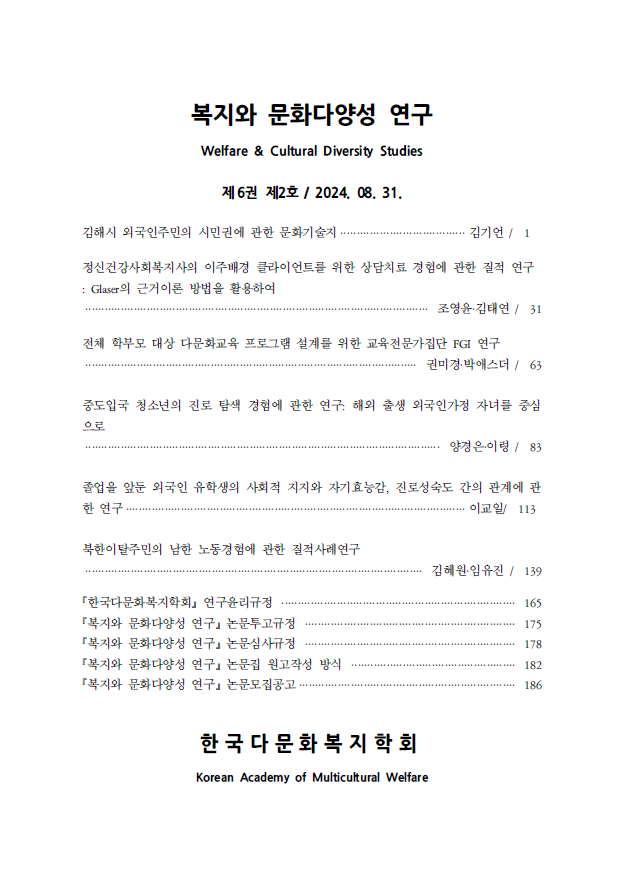김해시 외국인주민의 시민권에 관한 문화기술지
Research on citizenship of the foreign resident in Gimhae city by ethnography
- 한국다문화복지학회
- 복지와 문화다양성연구
- 복지와 문화다양성 연구 제6권 제2호
-
2024.081 - 29 (29 pages)
- 256

이 연구의 목적은 외국인 밀집지역에 거주하는 외국인주민이 스스로를 지역주민으로 인식하는 요소를 시민권의 관점에서 해석하고자 하였다. 연구참여자는 눈덩이 표집으로 6명을 선정하였다. 외국인주민이 스스로를 지역주민이라고 강조하는 사고의 패턴을 시민권의 관점에서 해석하고자 연구방법은 문화기술지를 선택하였다. 연구결과 시민권과 관련하여 두 개의 주제가 탐색되었다. 하나는 ‘오래 살아서 친근한 거주지’이다. ‘오래 살았다’는 속지주의의 거주기간에 해당한다. 살고 있는 곳을 친근하게 여기는 것은 외국인주민이 정착한 곳에서 소속감을 갖고 있음을 나타낸다. 다른 하나는 ‘김해시민이라는 소리 없는 아우성’이다. 주류사회가 외국인주민을 배제하며 이들에 관한 부정적 인식을 확산시키지만 외국인주민은 스스로 김해시민이라는 다양한 근거를 제시하였다. 하지만 주류사회는 아직 이들을 주민으로 수용하지 않는다. 이에 대해 이미 시행되고 있는 외국인의 정주 정책이 시민권과 함께 고려될 필요가 있음을 제안하였다. 또한 외국인 밀집지역에서 외국인주민의 조직화를 사회복지실천으로 제안하였다.
The purpose of this study was to analyze the factors that foreign residents living in a neighborhood with a high concentration of foreigners perceive themselves as local residents from the perspective of citizenship. Six participants were selected by snowball sampling. The research method was ethnography in order to analyze the patterns of thinking that foreign residents emphasize themselves as local residents from the perspective of citizenship. The results of the study revealed two themes related to citizenship. One is “long-lived and friendly residence”. “Long residence” corresponds to the duration of residence in a place. Being familiar with the place where you live shows that foreign residents have a sense of belonging to the place where they have settled. The other is “the silent shout of Gimhae citizens”. While mainstream society excludes foreign residents and spreads negative perceptions about them, foreign residents have provided various evidence that they are Gimhae citizens. However, mainstream society has not yet accepted them as residents. In response, the researchers suggested that the residency policy for foreigners, which is already in place, needs to be considered along with citizenship. They also suggested organizing foreign residents in areas where foreigners are concentrated as a social work practice.
Ⅰ. 서론
Ⅱ. 이론적 배경
Ⅲ. 연구방법
Ⅳ. 연구결과
Ⅴ. 논의 및 결론
(0)
(0)